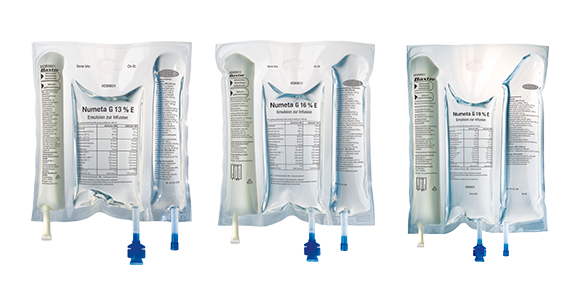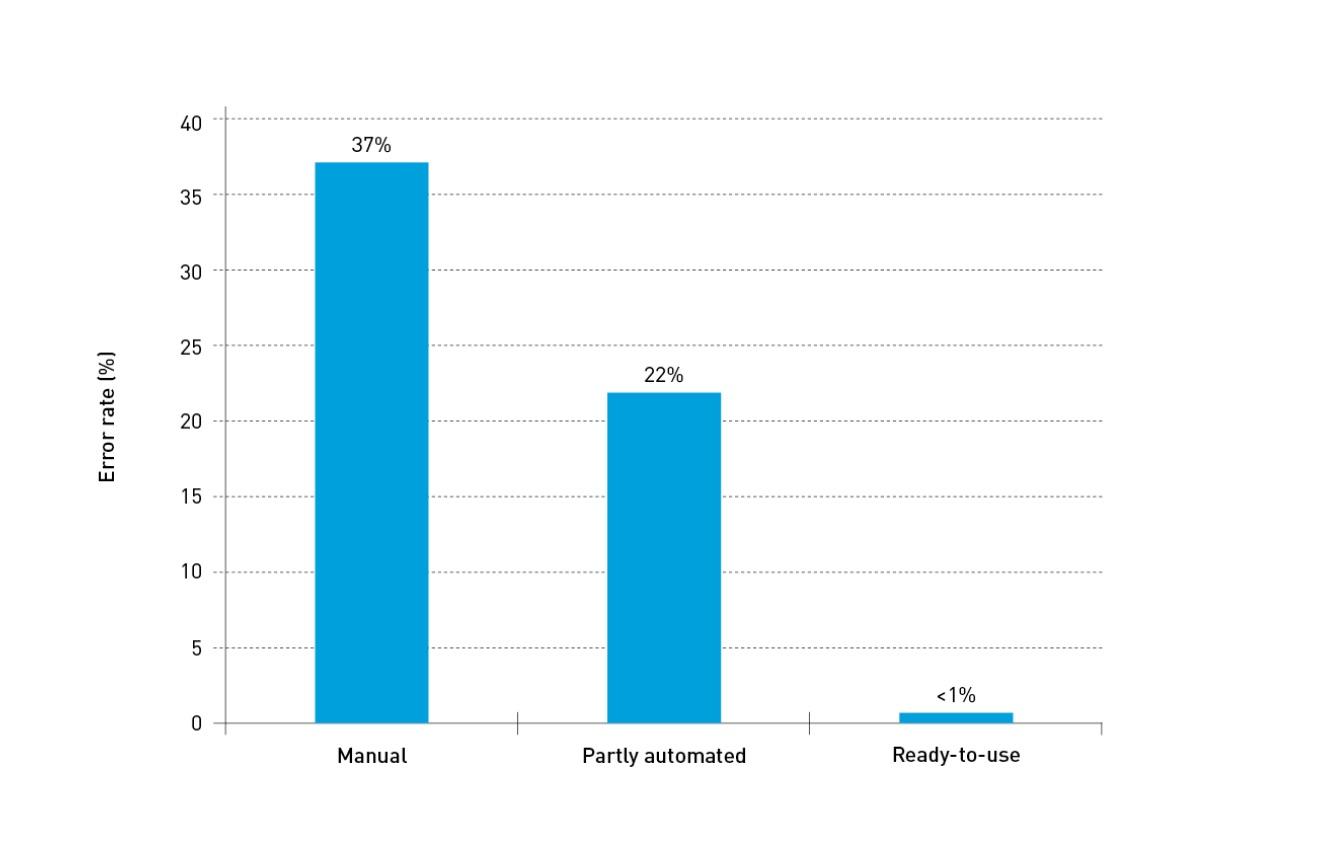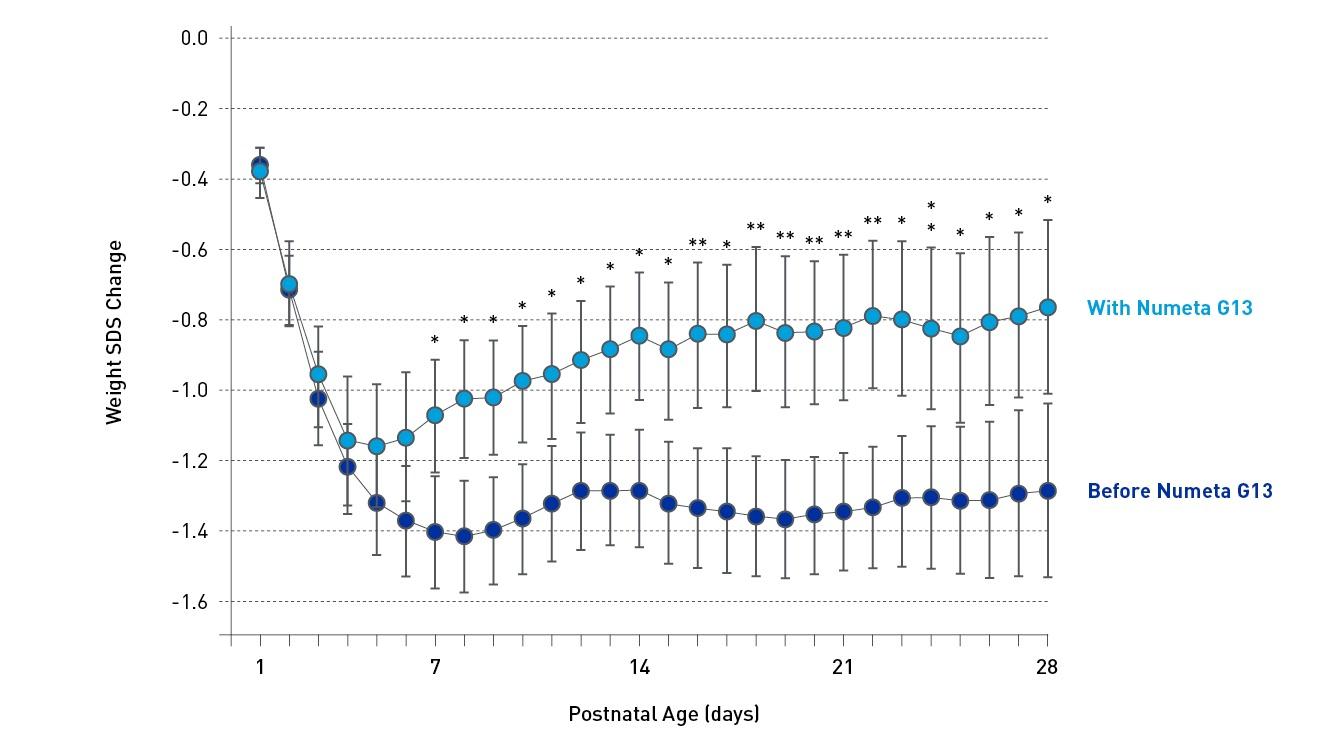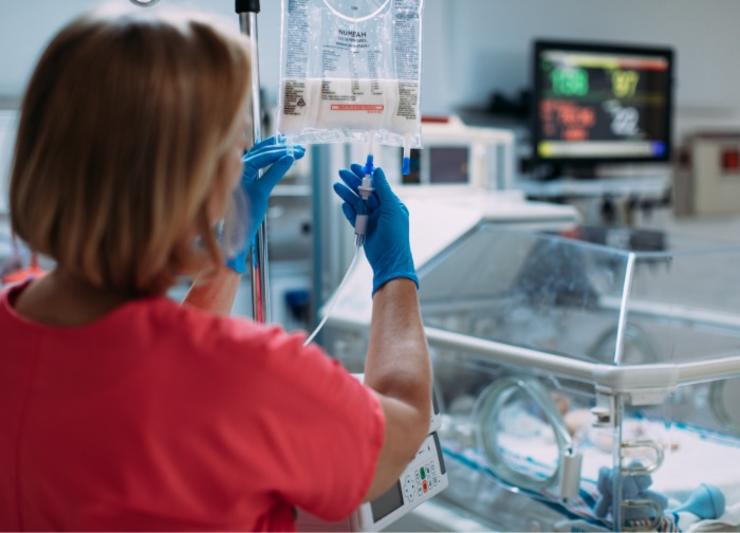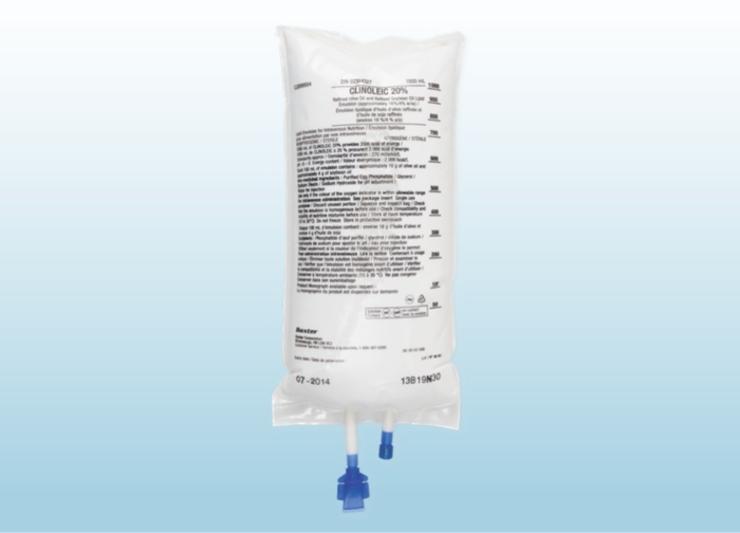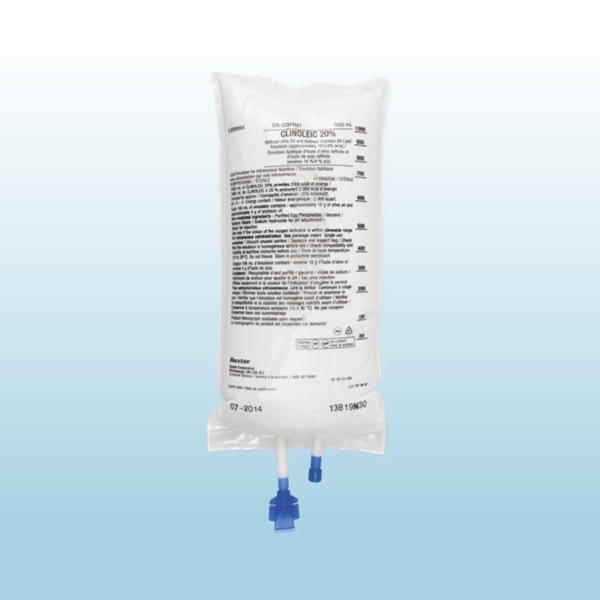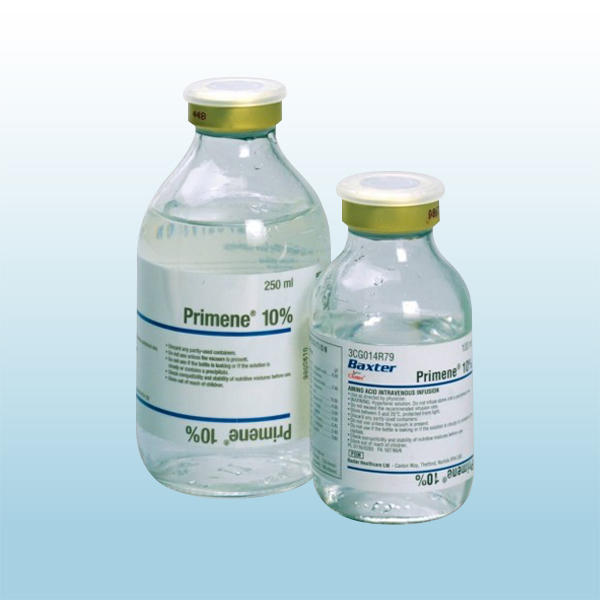Important safety information
Numeta G 13 % E Emulsion zur Infusion
Pharmakotherapeutische Gruppe: Lösungen zur parenteralen Ernährung / Kombinationen. ATC-Code: B05BA10.
QUALITATIVE UND QUANTITATIVE ZUSAMMENSETZUNG: Das Arzneimittel wird in einem Dreikammer-Beutel geliefert. Jeder Beutel enthält eine sterile, pyrogenfreie Kombination aus einer Glucoselösung, einer pädiatrischen Aminosäurenlösung mit Elektrolyten und einer Lipidemulsion, wie im Folgenden beschrieben. Beutelgröße: 300 ml: 50 %ige Glucoselösung: 80 ml/ 5,9 %ige Aminosäurenlösungen mit Elektrolyten: 160 ml/ 12,5%ige Lipidemulsion: 60 ml. Falls keine Lipide verabreicht werden sollen, kann nur die Trenn-Naht zwischen der Kammer mit Aminosäuren/Elektrolyten und Glucose geöffnet werden, so dass die Trenn-Naht zwischen Aminosäuren- und Lipid-Kammer verschlossen bleibt. Der Inhalt des Beutels kann anschließend mit oder ohne Lipide infundiert werden. Nach dem Mischen der Inhalte der zwei (Aminosäuren und Glucose, aktivierter 2-Kammer-Beutel, 240 ml Lösung) oder drei Kammern (Aminosäuren, Glucose und Lipide, aktivierter 3-Kammer-Beutel, 300 ml Emulsion) erhält man folgende Zusammensetzung: Wirkstoffe: Aktivierter 2KB (240 ml) Aminosäure-Kammer: Alanin 0,75 g/ Arginin 0,78 g/ Asparaginsäure 0,56 g/ Cystein 0,18 g/ Glutaminsäure 0,93 g/ Glycin 0,37 g/ Histidin 0,35 g/ Isoleucin 0,62 g/ Leucin 0,93 g/ Lysin-Monohydrat(entspricht Lysin) 1,15 g(1,03 g)/ Methionin 0,22 g/ Ornithinhydrochlorid (entspricht Ornithin) 0,30 g (0,23 g)/ Phenylalanin 0,39 g/ Prolin 0,28 g/ Serin 0,37 g/ Taurin 0,06 g/ Threonin 0,35 g/ Tryptophan 0,19 g/ Tyrosin 0,07 g/ Valin 0,71 g/ Kaliumacetat 0,61 g/ Calciumchlorid-Dihydrat 0,55 g/ Magnesiumacetat-Tetrahydrat 0,1 g/ Natriumglycerophosphat, hydratisiert 0,98 g Glucose-Kammer: Glucose-Monohydrat (entspricht wasserfreier Glucose) 44,00 g (40,00 g) Lipid-Kammer: Raffiniertes Olivenöl (ca. 80 %) + raffiniertes Sojaöl (ca. 20 %) – Aktivierter 3KB (300 ml)Aminosäure-Kammer: Alanin 0,75 g/ Arginin 0,78 g/ Asparaginsäure 0,56 g/ Cystein 0,18 g/ Glutaminsäure 0,93 g/ Glycin 0,37 g/ Histidin 0,35 g/ Isoleucin 0,62 g/ Leucin 0,93 g/ Lysin-Monohydrat(entspricht Lysin) 1,15 g(1,03 g)/ Methionin 0,22 g/ Ornithinhydrochlorid (entspricht Ornithin) 0,30 g (0,23 g)/ Phenylalanin 0,39 g/ Prolin 0,28 g/ Serin0,37 g/ Taurin 0,06 g/ Threonin 0,35 g/ Tryptophan 0,19 g/ Tyrosin 0,07 g/ Valin 0,71 g/ Kaliumacetat 0,61 g/ Calciumchlorid-Dihydrat 0,55 g/ Magnesiumacetat-Tetrahydrat 0,1 g/ Natriumglycerophosphat, hydratisiert 0,98 g Glucose-Kammer: Glucose-Monohydrat (entspricht wasserfreier Glucose) 44,00 g (40,00 g) Lipid-Kammer: Raffiniertes Olivenöl (ca. 80 %) + raffiniertes Sojaöl (ca. 20 %) 7,5g Liste der sonstigen Bestandteile: Aminosäure-Kammer: L-Äpfelsäure (1), Wasser für Injektionszwecke/ Glucose-Kammer: Salzsäure (1)/ Wasser für Injektionszwecke. Lipid-Kammer: Phospholipide aus Eiern zur Injektion / Glycerol/ Natriumoleat/ Natriumhydroxid (1)/ Wasser für Injektionszwecke. (1) zur pH-Einstellung
ANWENDUNGSGEBIETE: Numeta G 13 % E dient der parenteralen Ernährung von Frühgeborenen, wenn eine orale oder enterale Ernährung nicht möglich, unzureichend oder kontraindiziert ist.
GEGENANZEIGEN: Allgemeine Gegenanzeigen einer intravenösen Infusion von Numeta G 13 E bei Verwendung als Zweikammerbeutel sind: Überempfindlichkeit gegen Ei-, Soja- oder Erdnussproteine, gegen die Wirkstoffe, einen der sonstigen Bestandteile oder Bestandteile des Beutels. Angeborene Störungen des Aminosäurestoffwechsels. Pathologisch erhöhte Plasmaspiegel von Natrium, Kalium, Magnesium, Calcium und/oder Phosphor. Schwere Hyperglykämie. Die Verabreichung von Lipiden (Anwendung von Numeta G13 E als intravenöse Emulsion im Dreikammerbeutel) ist außerdem in folgenden klinischen Situationen kontraindiziert: Schwerer Hyperlipidämie oder schweren Störungen des Lipidmetabolismus, gekennzeichnet durch Hypertriglyceridämie.
INHABER DER ZULASSUNG. Baxter Healthcare GmbH, A-1020 Wien.
STAND DER INFORMATION: September 2020.
VERSCHREIBUNGSPFLICHT/APOTHEKENPFLICHT: Rezept- und apothekenpflichtig.
Weitere Angaben zu Warnhinweisen und Vorsichtsmaßnahmen für die Anwendung, Wechselwirkungen mit anderen Arzneimitteln oder sonstige Wechselwirkungen, Fertilität, Schwangerschaft und Stillzeit und Nebenwirkungen sind der veröffentlichten Fachinformation zu entnehmen.
Numeta G 16 % E Emulsion zur Infusion
Pharmakotherapeutische Gruppe: Lösungen zur parenteralen Ernährung / Kombinationen, ATC-Code: B05BA10.
QUALITATIVE UND QUANTITATIVE ZUSAMMENSETZUNG: Das Arzneimittel wird in einem Dreikammer-Beutel geliefert. Jeder Beutel enthalt eine sterile, pyrogenfreie Kombination aus einer Glucoselösung, einer pädiatrischen Aminosäurenlösung mit Elektrolyten und einer Lipidemulsion, wie im Folgenden beschrieben. Beutelgröße: 500ml: 50 %ige Glucoselösung: 155 ml/ 5,9 %ige Aminosäurenlösungen mit Elektrolyten: 221 ml/ 12,5%ige Lipidemulsion:124 ml. Falls keine Lipide verabreicht werden sollen, kann nur die Trenn-Naht zwischen der Kammer mit Aminosäuren/Elektrolyten und Glucose geöffnet werden, so dass die Trenn-Naht zwischen Aminosäuren- und Lipid-Kammer verschlossen bleibt. Der Inhalt des Beutels kann anschließend mit oder ohne Lipide infundiert werden. Nach dem Mischen der Inhalte der zwei (Aminosäuren und Glucose, aktivierter 2-Kammer-Beutel, 376 ml Lösung) oder drei Kammern (Aminosäuren, Glucose und Lipide, aktivierter 3-Kammer-Beutel, 500 ml Emulsion) erhalt man folgende Zusammensetzung: Wirkstoffe: Aktivierter 2KB (376 ml) Aminosäure-Kammer: Alanin 1,03 g / Arginin 1,08 g/ Asparaginsäure 0,77 g/ Cystein 0,24 g/ Glutaminsäure 1,29 g/ Glycin 0,51 g/ Histidin 0,49 g/ Isoleucin 0,86 g/ Leucin 1,29 g/ Lysin-Monohydrat(entspricht Lysin) 1,59 g(1,42 g)/ Methionin 0,31 g/ Ornithinhydrochlorid (entspricht Ornithin) 0,41 g (0,32 g)/ Phenylalanin 0,54 g/ Prolin 0,39 g/ Serin 0,51 g/ Taurin 0,08 g/ Threonin 0,48 g/ Tryptophan 0,26 g/ Tyrosin 0,10 g/ Valin 0,98 g/ Natriumchlorid 0,30 g/ Kaliumacetat 1,12 g/ Calciumchlorid-Dihydrat 0,46 g/ Magnesiumacetat-Tetrahydrat 0,33 g/ Natriumglycerophosphat, hydratisiert 0,98 g Glucose-Kammer: Glucose-Monohydrat (entspricht wasserfreier Glucose) 85,25 g (77,50 g) Lipid-Kammer: Raffiniertes Olivenöl (ca. 80 %) + raffiniertes Sojaöl (ca. 20 %) –Aktivierter 3KB (500 ml)Aminosäure-Kammer: Alanin 1,03 g/ Arginin 1,08 g/ Asparaginsäure 0,77 g/ Cystein 0,24 g/ Glutaminsäure 1,29 g/ Glycin 0,51 g/ Histidin 0,49 g/ Isoleucin 0,86 g/ Leucin 1,29 g/ Lysin-Monohydrat(entspricht Lysin) 1,59 g(1,43 g)/ Methionin 0,31 g/ Ornithinhydrochlorid (entspricht Ornithin) 0,41 g (0,32 g)/ Phenylalanin 0,54 g/ Prolin 0,39 g/ Serin 0,51 g/ Taurin 0,08 g/ Threonin 0,48 g/ Tryptophan 0,26 g/ Tyrosin 0,10 g/ Valin 0,98 g/ Natriumchlorid 0,30 g/ Kaliumacetat 1,12 g/ Calciumchlorid-Dihydrat 0,46 g/ Magnesiumacetat-Tetrahydrat 0,33 g/ Natriumglycerophosphat, hydratisiert 0,98 g Glucose-Kammer: Glucose-Monohydrat (entspricht wasserfreier Glucose) 85,25 g (77,50 g). Lipid-Kammer: Raffiniertes Olivenöl (ca. 80 %) + 15,5g/ raffiniertes Sojaöl (ca. 20 %) 7,5g. Liste der sonstigen Bestandteile: Aminosaure-Kammer: L-Apfelsäure (1), Wasser für Injektionszwecke/ Glucose-Kammer: Salzsäure (1)/ Wasser für Injektionszwecke; Lipid-Kammer: Phospholipide aus Eiern zur Injektion / Glycerol/ Natriumoleat/ Natriumhydroxid (1)/ Wasser für Injektionszwecke. (1)zur pH Einstellung. ANWENDUNGSGEBIETE: Numeta G 16 % E dient der parenteralen Ernährung von reifen Neugeborenen, Säuglingen und Kindern bis 2 Jahren, wenn eine orale oder enterale Ernährung nicht möglich, unzureichend oder kontraindiziert ist.
GEGENANZEIGEN: Allgemeine Gegenanzeigen einer intravenösen Infusion von Numeta G 16 % E bei Verwendung als Zweikammerbeutel sind: Überempfindlichkeit gegen Ei-, Soja- oder Erdnussproteine, gegen die Wirkstoffe, einen der sonstigen Bestandteile (gelistet in Abschnitt 6.1) oder Bestandteile des Beutels; Angeborene Störungen des Aminosäurestoffwechsels; Pathologisch erhöhte Plasmaspiegel von Natrium, Kalium, Magnesium, Calcium und/oder Phosphor. Wie für andere calciumhaltige Infusionslösungen die gleichzeitige Verabreichung mit Ceftriaxon bei Neugeborenen (≤ 28 Tage). Dies gilt auch bei Verwendung verschiedener venöser Zugänge (Risiko von schwerwiegenden Präzipitaten im Blutkreislauf der Neugeborenen (siehe Abschnitte 4.4, 4.5 und 6.2); Schwere Hyperglykämie; Die Verabreichung von Lipiden (Anwendung von Numeta G 16 % E als intravenöse Emulsion im Dreikammerbeutel) ist außerdem in folgenden klinischen Situationen kontraindiziert: Schwerer Hyperlipidämie oder schweren Störungen des Lipidmetabolismus, gekennzeichnet durch Hypertriglyceridämie.
INHABER DER ZULASSUNG: Baxter Healthcare GmbH, A-1020 Wien.
STAND DER INFORMATION: September 2020.
VERSCHREIBUNGSPFLICHT/APOTHEKENPFLICHT: Rezept- und apothekenpflichtig. Weitere Angaben zu „Besondere Warnhinweise und Vorsichtsmaßnahmen für die Anwendung“, „Wechselwirkungen mit anderen Arzneimitteln und sonstige Wechselwirkungen“, „Fertilität, Schwangerschaft und Stillzeit“ und „Nebenwirkungen“ sind der veröffentlichten Fachinformation zu entnehmen.
Numeta G 19 % E Emulsion zur Infusion
Pharmakotherapeutische Gruppe: Lösungen zur parenteralen Ernährung / Kombinationen, ATC-Code: B05BA10
QUALITATIVE UND QUANTITATIVE ZUSAMMENSETZUNG: Das Arzneimittel wird in einem Dreikammer-Beutel geliefert. Jeder Beutel enthält eine sterile, pyrogenfreie Kombination aus einer Glucoselösung, einer pädiatrischen Aminosäurenlösung mit Elektrolyten und einer Lipidemulsion, wie im Folgenden beschrieben. Beutelgröße:1000 ml: 50 %ige Glucoselösung: 383 ml/ 5,9 %ige Aminosäurenlösungen mit Elektrolyten: 392 ml/ 12,5%ige Lipidemulsion: 225 ml. Falls keine Lipide verabreicht werden sollen, kann nur die Trenn-Naht zwischen der Kammer mit Aminosäuren/Elektrolyten und Glucose geöffnet werden, so dass die Trenn-Naht zwischen Aminosäuren- und Lipid-Kammer verschlossen bleibt. Der Inhalt des Beutels kann anschließend mit oder ohne Lipide infundiert werden. Nach dem Mischen der Inhalte der zwei (Aminosäuren und Glucose, 2-Kammer-Beutel, 775 mL Lösung) oder drei Kammern (Aminosäuren, Glucose und Lipide, 3-Kammer-Beutel, 1000 mL Emulsion) erhält man folgende Zusammensetzung: Wirkstoffe: Aktivierter 2KB (775 ml) Aminosäure-Kammer: Alanin 1,83 g / Arginin 1,92 g/ Asparaginsäure 1,37 g/ Cystein 0,43 g/ Glutaminsäure 2,29 g/ Glycin 0,91 g/ Histidin 0,87 g/ Isoleucin 1,53 g/ Leucin 2,29 g/ Lysin-Monohydrat(entspricht Lysin) 2,82 g(2,51 g)/ Methionin 0,55 g/ Ornithinhydrochlorid (entspricht Ornithin) 0,73 g (0,57 g)/ Phenylalanin 0,96 g/ Prolin 0,69 g/ Serin 0,91 g/ Taurin 0,14 g/ Threonin 0,85 g/ Tryptophan 0,46 g/ Tyrosin 0,18 g/ Valin 1,74 g/ Natriumchlorid 1,79g/ Kaliumacetat 3,14 g/ Calciumchlorid-Dihydrat 0,56 g/ Magnesiumacetat-Tetrahydrat 0,55 g/ Natriumglycerophosphat, hydratisiert 2,21 g Glucose-Kammer: Glucose-Monohydrat (entspricht wasserfreier Glucose) 210,65 g (191,50 g) Lipid-Kammer: Raffiniertes Olivenöl (ca. 80 %) + raffiniertes Sojaöl (ca. 20 %) –Aktivierter 3KB (1000 ml)Aminosäure-Kammer: Alanin 1,83 g / Arginin 1,92 g/ Asparaginsäure 1,37 g/ Cystein 0,43 g/ Glutaminsäure 2,29 g/ Glycin 0,91 g/ Histidin 0,87 g/ Isoleucin 1,53 g/ Leucin 2,29 g/ Lysin-Monohydrat(entspricht Lysin) 2,82 g(2,51 g)/ Methionin 0,55 g/ Ornithinhydrochlorid (entspricht Ornithin) 0,73 g (0,57 g)/ Phenylalanin 0,96 g/ Prolin 0,69 g/ Serin 0,91 g/ Taurin 0,14 g/ Threonin 0,85 g/ Tryptophan 0,46 g/ Tyrosin 0,18 g/ Valin 1,74 g/ Natriumchlorid 1,79g/ Kaliumacetat 3,14 g/ Calciumchlorid-Dihydrat 0,56 g/ Magnesiumacetat-Tetrahydrat 0,55 g/ Natriumglycerophosphat, hydratisiert 2,21 g Glucose-Kammer: Glucose-Monohydrat (entspricht wasserfreier Glucose) 210,65 g (191,50 g) Lipid-Kammer: Raffiniertes Olivenöl (ca. 80 %) + 15,5g/ raffiniertes Sojaöl (ca. 20 %) 28,1g Liste der sonstigen Bestandteile: Aminosäure-Kammer: L-Äpfelsäure (1), Wasser für Injektionszwecke/ Glucose-Kammer: Salzsäure (1)/ Wasser für Injektionszwecke; Lipid-Kammer: Phospholipide aus Eiern zur Injektion / Glycerol/ Natriumoleat/ Natriumhydroxid (1)/ Wasser für Injektionszwecke (1)zur pH-Einstellung
ANWENDUNGSGEBIETE: Numeta G19 % E dient der parenteralen Ernährung von Kindern und Jugendlichen vom vollendeten 2. bis zum vollendeten 18. Lebensjahr, wenn eine orale oder enterale Ernährung nicht möglich, unzureichend oder kontraindiziert ist.
GEGENANZEIGEN: Allgemeine Gegenanzeigen einer intravenösen Infusion von Numeta G 19 % E bei Verwendung als Zweikammerbeutel sind: Überempfindlichkeit gegen Ei-, Soja- oder Erdnussproteine, gegen die Wirkstoffe, einen der sonstigen Bestandteile (gelistet in Abschnitt 6.1) oder Bestandteile des Beutels. Angeborene Störungen des Aminosäurestoffwechsels. Pathologisch erhöhte Plasmaspiegel von Natrium, Kalium, Magnesium, Calcium und/oder Phosphor. Schwere Hyperglykämie. Die Verabreichung von Lipiden (Anwendung von Numeta als intravenöse Emulsion im Dreikammerbeutel) ist außerdem in folgenden klinischen Situationen kontraindiziert: Schwerer Hyperlipidämie oder schweren Störungen des Lipidmetabolismus, gekennzeichnet durch Hypertriglyceridämie
INHABER DER ZULASSUNG : Baxter Healthcare GmbH, A-1020 Wien
STAND DER INFORMATION: September 2020.
VERSCHREIBUNGSPFLICHT/APOTHEKENPFLICHT: Rezept- und apothekenpflichtig.
Weitere Angaben zu „Besondere Warnhinweise und Vorsichtsmaßnahmen für die Anwendung“, „Wechselwirkungen mit anderen Arzneimitteln und sonstige Wechselwirkungen“, „Fertilität, Schwangerschaft und Stillzeit“ und „Nebenwirkungen“ sind der veröffentlichten Fachinformation zu entnehmen.
